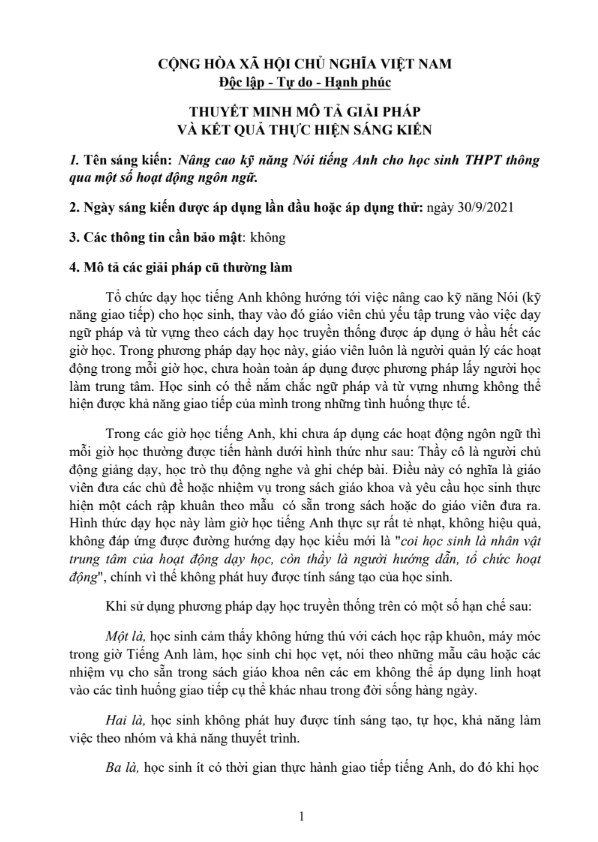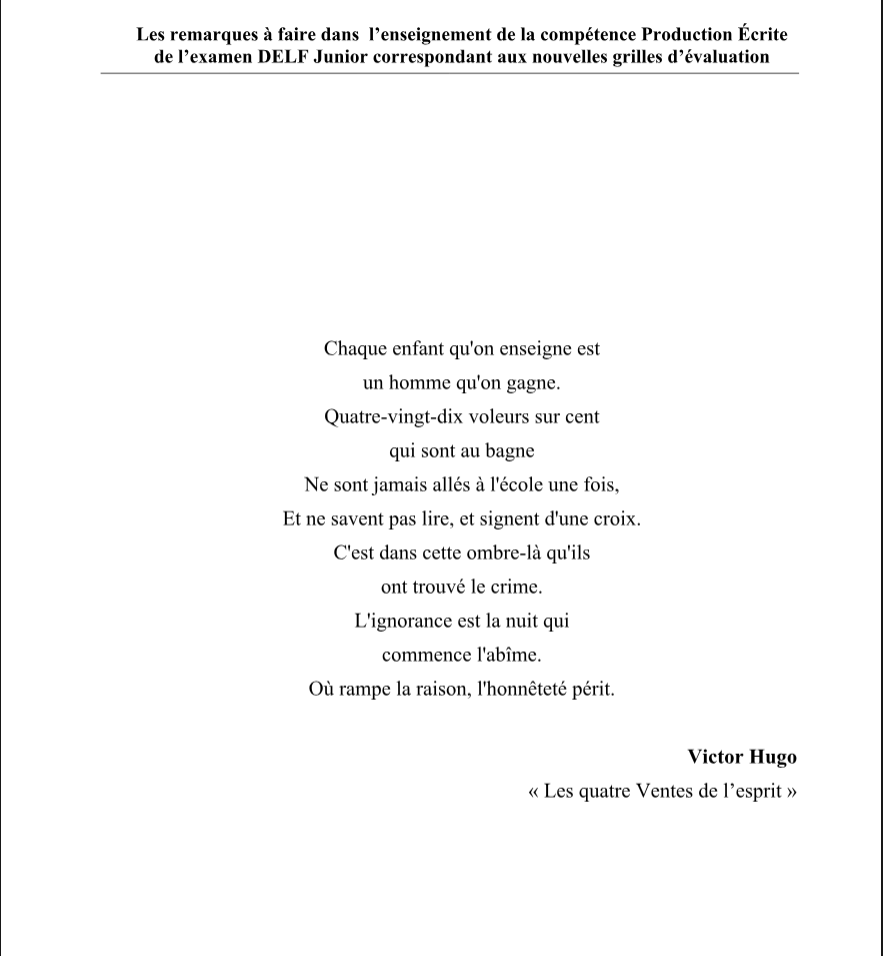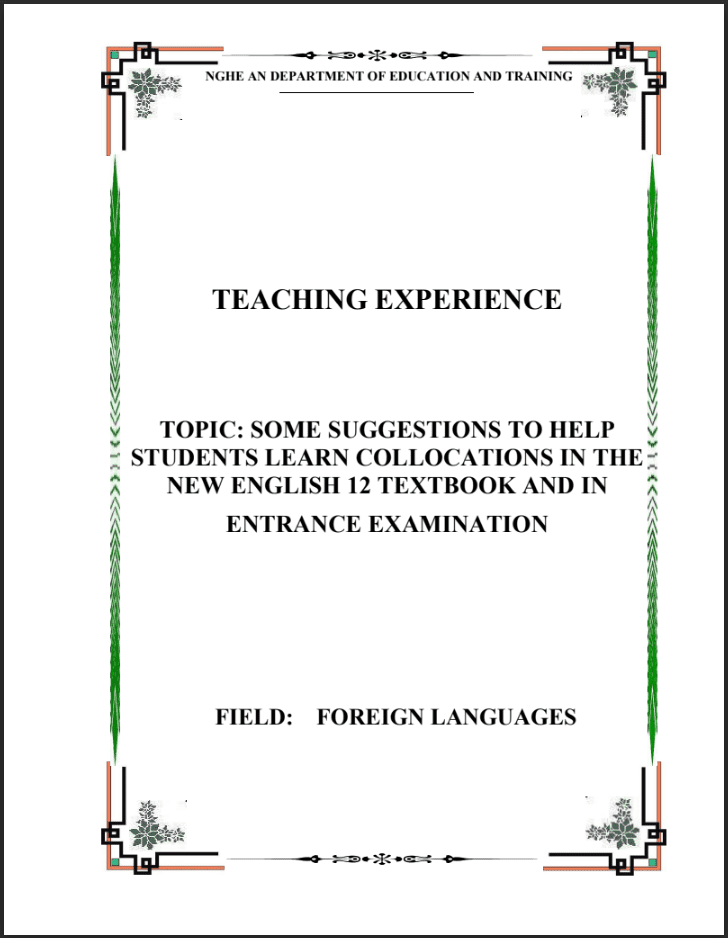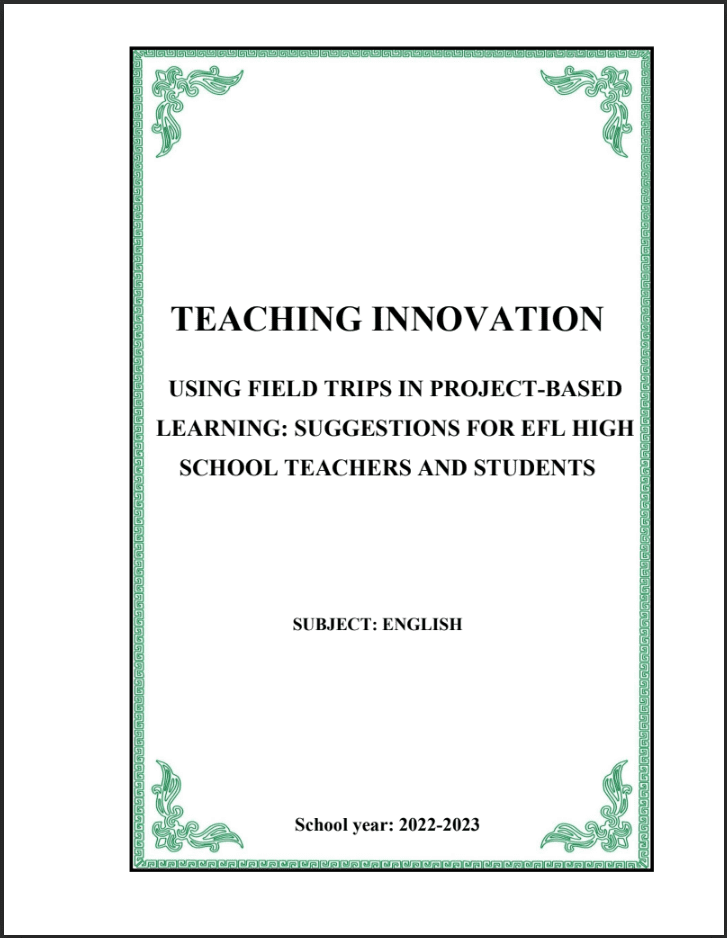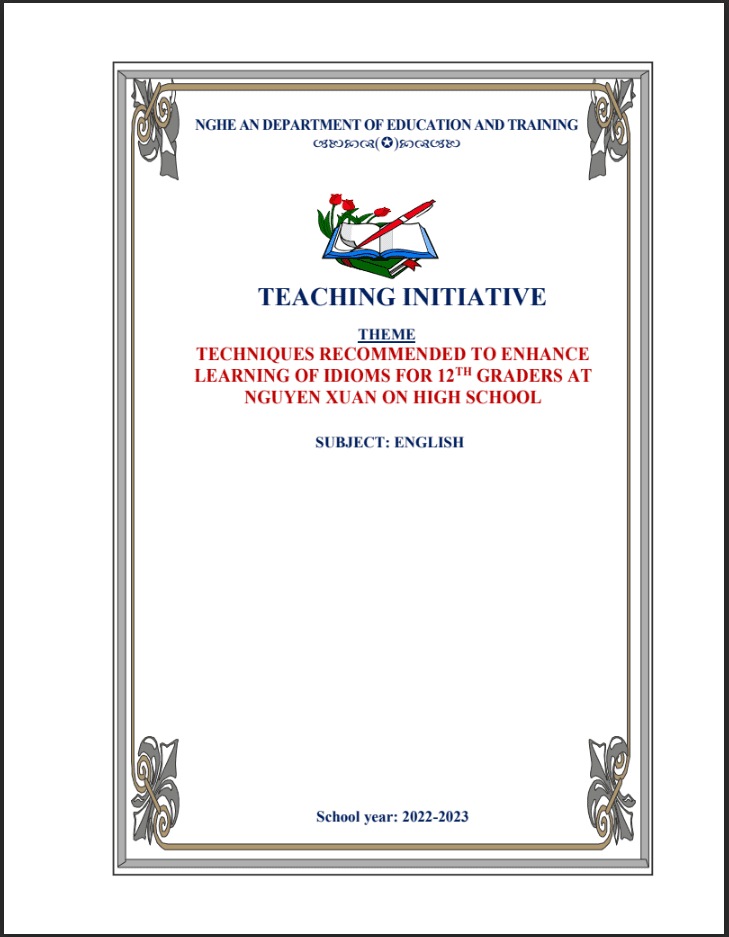SKKN Fostering creativity in addressing assigned tasks to enhance high school students English learning motivation
- Mã tài liệu: MP0062 Copy
| Môn: | Tiếng anh |
| Lớp: | 12 |
| Bộ sách: | |
| Lượt xem: | 957 |
| Lượt tải: | 8 |
| Số trang: | 63 |
| Tác giả: | Lê Thị Thu Trang |
| Trình độ chuyên môn: | Cử nhân đại học |
| Đơn vị công tác: | THPT Phan Đăng Lưu |
| Năm viết: | 2021-2022 |
| Số trang: | 63 |
| Tác giả: | Lê Thị Thu Trang |
| Trình độ chuyên môn: | Cử nhân đại học |
| Đơn vị công tác: | THPT Phan Đăng Lưu |
| Năm viết: | 2021-2022 |
Sáng kiến kinh nghiệm “SKKN Fostering creativity in addressing assigned tasks to enhance high school students English learning motivation” triển khai gồm các biện pháp nổi bật sau:
– Competitions of designing slogans
– Projects on speaking tasks
– . Dramatizing the lesson
– Projects on vocabulary
– Extra-curriculum activities
Mô tả sản phẩm
PART 1: INTRODUCTION
1. Rationale
In the current context of globalization, the English language as an international means of communication is growing in popularity. An obvious advantage is that having a good command of English could help transform a person‟s life. Not only does it open him to a world full of both professional and personal possibilities, but it also expands his thinking and can prime his confidence. Accordingly, the teaching and learning English is increasingly gaining the attention from the government and the public. However, in reality, our students‟ English is not very good and neither is their performance in tests and examinations.
To the best of the author‟s knowledge, motivation has a profound effect on people‟s language learning. However, her students‟ driving force for learning English engagement is rather low. Many students are not interested in and do not invest enough time and effort in learning it. Also, their perceived aptitude to learn and ability to use it in the future are not high. Meanwhile, many tasks or activities in textbooks are not interesting enough to keep students engaged. Therefore, it is vital that teachers of English have more effective methods and more attractive activities to help students increase their motivation in learning the target language.
Theoretically and practically, there are a wide variety of ways to motivate pupils in language classrooms. In the light of some literature of creativity, the author realizes that there is a close relationship between creativity and motivation in language learning and that through stimulating students‟ creativity, their motivation in language learning could be improved. It is argued that creativity is a crucial component of childhood development that encourages problem-solving and critical thinking skills, and learning through play. It is intrinsic in nature, which directly improves learning by increasing motivation, deepening understanding, and promoting joy. That is the reason why the study was carried out, entitled „Fostering creativity in addressing assigned tasks to enhance high school students‟ English learning motivation‟.
2. Aims of the study
The study aims at suggesting some kinds of tasks which stimulate students‟ creativity with a view to motivating students to learn English.
PART 2: CONTENT
I. THEORITICAL BACKGROUND
1. An overview of motivation
1.1. What is motivation?
Motivation is accepted for most fields of learning to be essential to success. Without motivation, we will almost certainly fail to make necessary efforts. Therefore, it makes sense to try and develop our understanding of it.
Motivation is defined in different ways by different researchers. According to Marion Williams and Richard Burden (1997: 120), motivation is a „state of cognitive arouse‟ which provokes a „decision to act‟ as a result of which there is „sustained intellectual and/or physical effort‟ so that the person can achieve some „previously set goal‟. Sharing the same view, Jeremy Harmer (2001:51) states that „at its most basic level, motivation is some kind of internal drive which pushes someone to do things in order to achieve something. Additionally, Woolfolk (2001:366) defines motivation as „an internal state that arouses, directs and maintains behaviour‟.
Briefly, motivation is something involving the attitudes and affective states that influence the degree of effort that one makes to achieve some certain goal.
1.2. Importance of motivation in language learning
Learner motivation has become more commonly recognised as perhaps the major determining factor for successful learning in general, whether one is an adult learner taking distance education courses or an upper secondary school student who puts his way through the battery of required courses needed to graduate. In terms of language acquisition, it has been found in various studies that motivation is very strongly related to achievement in language learning. As William T. Littlewood puts it (1984:
53), „in second language learning as in every other field of human learning, motivation is the crucial force which determines whether a learner embarks on a task at all, how much energy he devotes to it, and how long he perseveres‟. Besides, Tricia Hedge (2000: 23) affirms: „motivation is of crucial importance in the classroom, whether learners arrive with it or whether they acquire it through classroom experiences‟. Regarding this issue, Oxford and Shearin (1996: 122) also argue: „Motivation is important because it directly influences how often students use L2 learning strategies, how much students interact with native speakers, how much input they receive in the target language, how well they do on curriculum-related achievement tests, how high their general proficiency level becomes, and how long they persevere and maintain L2 skills after language study is over. Therefore, motivation is crucial for L2 learning, and it is essential to understand what our students‟ motivation is‟. As a result, it is vital that motivation be put emphasis on in the teaching and learning second language.
2. An overview of creativity
2.1. What is creativity?
Creativity, which can be defined as the ability to bring something original and valuable into the world, is not reserved for a privileged few artists or intellectuals. Creativity can occur in almost any field. It happens in art, music, mathematics, engineering, science, business and education. Anywhere there are problems to be solved or the mind seeks expression, creativity can be found. „We all have the potential to be creative. This potential can be cultivated by finding the specific means for enhancing creativity in a given individual or group. In fact, research on creativity shows it can be fostered in anyone‟ (Neumann, 2007).
2.2. Role of creativity in language learning
A good classroom environment always has some elements of creativity which make lessons more interesting and interactive. The right mix of creativity along with curriculum helps students to be innovative and also encourages them to learn new things. Students can grow up as good communicators in addition to improving their emotional and social skills. Creative classrooms can really transform the way students acquire education and how they apply it in their real life. In fact, creative expression plays a key role in a student‟s emotional development. “Create” is one of the highest taxonomic levels in Bloom‟s taxonomy, which has been used to define taxonomic levels in learning since the 1950s.
As regards the role of creativity in language learning, Judit Fehér argues on the website www.teachingenglish.org.uk that language use is a creative act. We transform thoughts into language that can be heard or seen. We are capable of producing sentences and even long texts that we have never heard or seen before. By giving learners creative exercises, we get them to practise an important sub-skill of using a language: thinking creatively. She also adds: „My experience also taught me that most people become more motivated, inspired or challenged if they can create something of value‟.
3. An overview of assigned tasks
3.1. Importance of assigned learning tasks
Assigned tasks play a vital role in the teaching and learning process. Not only do they help learners to focus on the essential learning, but they also give teachers opportunities to provide individual feedback for learners and evaluate what is working on their course and what aspects need improvement. Moreover, a successfully completed assignment will contribute to the learner‟s growing sense of confidence in himself as a professional in the field in which he is studying.
3.2. Some things to be taken account when designing tasks
According to Allison Boye, Ph.D., „ultimately, the success of student responses to an assignment often rests on the instructor’s deliberate design of the assignment. By being purposeful and thoughtful from the beginning, you can ensure that your assignments will not only serve as effective assessment methods, but also engage and
TÀI LIỆU LIÊN QUAN
- 7
- 105
- 1
- [product_views]
- 5
- 173
- 2
- [product_views]
- 4
- 165
- 3
- [product_views]
- 4
- 129
- 4
- [product_views]
100.000 ₫
- 6
- 434
- 5
- [product_views]
100.000 ₫
- 2
- 507
- 6
- [product_views]
100.000 ₫
- 9
- 546
- 7
- [product_views]
100.000 ₫
- 4
- 409
- 8
- [product_views]
100.000 ₫
- 2
- 595
- 9
- [product_views]
100.000 ₫
- 0
- 538
- 10
- [product_views]





